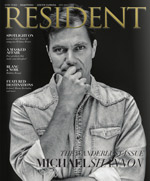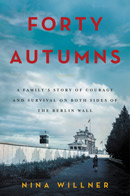Resident Magazine December 2016 . Read book reviews by Frederic Colier
. Read book reviews by Frederic Colier
online. Feature article is about Ian Mellencamp (nephew of John M).
Only in the Resident Magazine.
Resident Magazine December 2016 . Read book reviews by Frederic Colier
. Read book reviews by Frederic Colier
online. Feature article is about Ian Mellencamp (nephew of John M).
Only in the Resident Magazine.
 “Quick Sand” by Malin Persson Giolito
“Quick Sand” by Malin Persson Giolito
(trans. Rachel Willson-Broyles, Other Press, pp 432, $26.95)
Kudos to Other Press for publishing this Nordic wonder. “Quick Sand” has been bestsellers in more than 20 countries, mainly the old continent, and despite its success, it was shocking to see that no US publisher would rush to snatch up the US rights. “Quick Sand” is Persson Giolito‘s fourth crime novel. The story takes its cue from a mass killing, such as the one which took place in Norway in 2011 . . . Its main protagonist, the 18-year old, Maja Norberg, is a popular student who survives a school rampage. Set as a flashback, prior to the gory event, the plot trails Maja’s past to find out whether she participated in the mass murdering. She has been accused, being the only one to survive, and waits in jail for her trial.
This alone would not have been enough to get this book included in this month column. But Persson Giolito’s craft takes us on a psychological ride, where perhaps the narrator of the story is not as reliable as first thought. She met a questionable character, Sebastian Fagerman, prior to the massacre. Little by little, we can hear the cogs of her internal life flicker with strange sounds. As she is swept off her feet, alienating everyone in her immediate circle, we ponder if her outcries are not simply screams for help . . . that everyone missed. Then do we want her to be guilty? Do we want her to be innocent? Or do we simply want to be passers-by entertained by her story? . . . You will have to listen to yourself very careful as you read this unnerving book. You do not want to be missing something.
 Resident Magazine November 2016. Read book reviews by Frederic Colier
Resident Magazine November 2016. Read book reviews by Frederic Colier
online. Feature article is about Michael Shannon. Only in the Resident Magazine.
 “Heads,” by Jesse Jarnow
“Heads,” by Jesse Jarnow
(Da Capo Press, pp 468, $27.99)
If you are a fan of books dealing with the history of salt, timber or something more exotic like sex, you will delight in “Heads,” a book about psychedelics. Though the term has now gained multiple definitions, notably in relation to music and culture, the psychedelics refer to here belong to drugs, yes narcotics. A well-time book, given the massive popular wave to legalize Marijuana. However, you will find no bell chiming in favor of psych drugs.
In this well-documented spiraling history of how these drugs transformed our present culture, Jesse Jarnow offers a fresh outlook. While we can talk about peyote and other forms of LSD derivatives, it is impossible to understand the meaning of Psychedelic without going back to the 60’s, starting first as a counter-culture on the eve of the Vietnam War and the Civil Right Movements. Thinking Huxley having a bad trip in “Doors of Perception,” or Leary’s promoting drugs in Harvard, via Richard Alpert, aka Ram Dass, experiencing a spiritual awakening, would confine the movement to known anecdotes.
Jesse Jarnow has dug deep into the roots of Psychedelia. For a generation, which perceived itself as living in a repressive society, music became the catalyst of a cultural revolution, the bedfellow able to unleash repressed psychological emotions. If Grateful Dead means anything to you, I will set you on course, as you may wonder what “New Age practices, hacktivism, yoga, natural childbirth, Burning Man, Central Park graffiti, with artist like Bilrock and the late Keith Haring, and the internet, have in common. The answer may surprise you.
 “Forty Autumns: a Family’s Story of Courage and Survival on Both Sides of the Berlin Wall,” by Nina Willner
“Forty Autumns: a Family’s Story of Courage and Survival on Both Sides of the Berlin Wall,” by Nina Willner
(William Morrow, pp 397, $27.99)
The title spells it all. “Forty Autumns,” is about survival on both sides of the Berlin Wall. If you know the history of the Cold War, you will quickly infer that we are talking about two different kinds of survival. East and West spell out different hardships. In the case of the East, we are dealing with communist repression on all fronts in a Big-Brother-like society, restriction of liberties, listening, spying, suspecting, ideological enforcement, in brief, a constant climate of distrust and cultivated fear. For the West, the survival is more nuanced. It comes from isolation, fragmented family, unfulfilled desires, which, perhaps, indirectly, is the consequence of the severed ties created by the Berlin Wall.
In this historical memoir, Nina Willner tells us the story of her family, the escape of her mother, Hannah, into the West, and her struggle to survive away from her family. A family she would only be reunited to 40 years later, after the fall of the Wall. “Forty Autumns,” emphasizes the metaphor that sometime politics and ideologies act as crushing silent forces standing in the way of families, and their reconciliation. What makes the book stand out from memoirs on the same topic comes from the author’s real life situation. Nina Willner worked for the American Intelligence and got to be stationed in Berlin, during the cold war, just a few miles away from her Eastern family . . . and got to lead missions into the Eastern block. No matter what, human spirit always prevails.